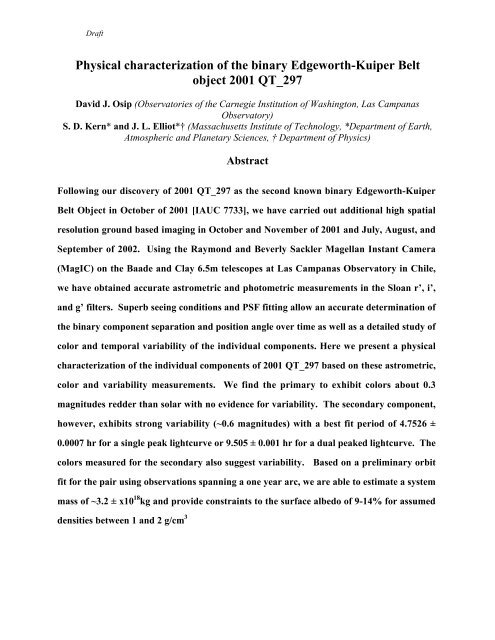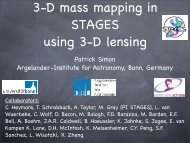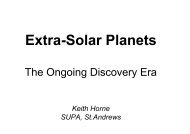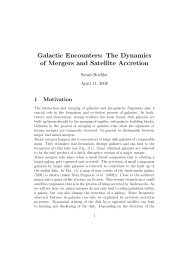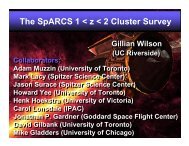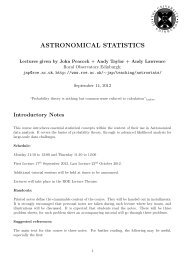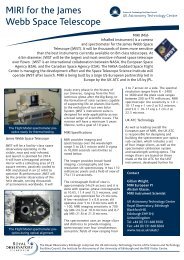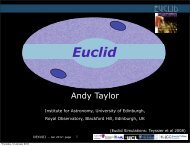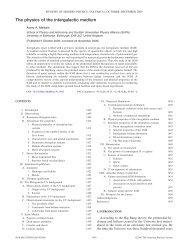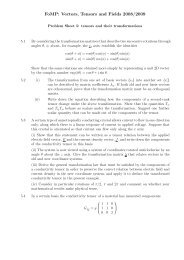Physical Characterisation of the Binary EKBO 2001 QT297
Physical Characterisation of the Binary EKBO 2001 QT297
Physical Characterisation of the Binary EKBO 2001 QT297
Create successful ePaper yourself
Turn your PDF publications into a flip-book with our unique Google optimized e-Paper software.
Draft<br />
<strong>Physical</strong> characterization <strong>of</strong> <strong>the</strong> binary Edgeworth-Kuiper Belt<br />
object <strong>2001</strong> QT_297<br />
David J. Osip (Observatories <strong>of</strong> <strong>the</strong> Carnegie Institution <strong>of</strong> Washington, Las Campanas<br />
Observatory)<br />
S. D. Kern* and J. L. Elliot*† (Massachusetts Institute <strong>of</strong> Technology, *Department <strong>of</strong> Earth,<br />
Atmospheric and Planetary Sciences, † Department <strong>of</strong> Physics)<br />
Abstract<br />
Following our discovery <strong>of</strong> <strong>2001</strong> QT_297 as <strong>the</strong> second known binary Edgeworth-Kuiper<br />
Belt Object in October <strong>of</strong> <strong>2001</strong> [IAUC 7733], we have carried out additional high spatial<br />
resolution ground based imaging in October and November <strong>of</strong> <strong>2001</strong> and July, August, and<br />
September <strong>of</strong> 2002. Using <strong>the</strong> Raymond and Beverly Sackler Magellan Instant Camera<br />
(MagIC) on <strong>the</strong> Baade and Clay 6.5m telescopes at Las Campanas Observatory in Chile,<br />
we have obtained accurate astrometric and photometric measurements in <strong>the</strong> Sloan r’, i’,<br />
and g’ filters. Superb seeing conditions and PSF fitting allow an accurate determination <strong>of</strong><br />
<strong>the</strong> binary component separation and position angle over time as well as a detailed study <strong>of</strong><br />
color and temporal variability <strong>of</strong> <strong>the</strong> individual components. Here we present a physical<br />
characterization <strong>of</strong> <strong>the</strong> individual components <strong>of</strong> <strong>2001</strong> QT_297 based on <strong>the</strong>se astrometric,<br />
color and variability measurements. We find <strong>the</strong> primary to exhibit colors about 0.3<br />
magnitudes redder than solar with no evidence for variability. The secondary component,<br />
however, exhibits strong variability (~0.6 magnitudes) with a best fit period <strong>of</strong> 4.7526 ±<br />
0.0007 hr for a single peak lightcurve or 9.505 ± 0.001 hr for a dual peaked lightcurve. The<br />
colors measured for <strong>the</strong> secondary also suggest variability. Based on a preliminary orbit<br />
fit for <strong>the</strong> pair using observations spanning a one year arc, we are able to estimate a system<br />
mass <strong>of</strong> ~3.2 ± x10 18 kg and provide constraints to <strong>the</strong> surface albedo <strong>of</strong> 9-14% for assumed<br />
densities between 1 and 2 g/cm 3
Draft<br />
1. Introduction<br />
Pluto was discovered in 1930, and rotational variability was well observed for several decades<br />
(cf. Stern 1992). However, it wasn't until 1978 that <strong>the</strong> ninth planet in <strong>the</strong> solar system was<br />
found to have a companion, Charon (Christy and Harrington, 1978). Subsequent study <strong>of</strong> this<br />
binary system, especially during a 5-year period <strong>of</strong> mutual eclipses and occultations, provided a<br />
detailed characterization <strong>of</strong> Pluto and Charon, including accurate estimates <strong>of</strong> <strong>the</strong>ir diameters,<br />
albedos, masses, and densities (Tholen and Buie, 1997; Young et al., 2000). For solar-system<br />
bodies without a binary companion or natural satellite, accurate estimates <strong>of</strong> most <strong>of</strong> <strong>the</strong>se<br />
physical characteristics require a close spacecraft encounter.<br />
Until recently Pluto-Charon remained <strong>the</strong> only known binary system in <strong>the</strong> trans-Neptunian<br />
region. Pluto and Charon are large and close (currently < 32 AU) objects in comparison to <strong>the</strong><br />
bodies thus far detected in <strong>the</strong> Edgeworth-Kuiper Belt (EKB). The Pluto-Charon system is<br />
thought to have formed via a catastrophic collision, reaccretion <strong>of</strong> <strong>the</strong> debris cloud, and relatively<br />
rapid tidal evolution to <strong>the</strong> presently observed locked state (where <strong>the</strong> orbital period is identical to<br />
Pluto's rotation period such that Pluto always shows <strong>the</strong> same face to Charon). A similarly<br />
evolved binary EKO with much smaller diameters (~100-300 km) would have tidally evolved in<br />
a short time period (Toth, 1999; Weidenschilling et al., 1989) to a separation <strong>of</strong> approximately<br />
2000 km, which would subtend an angle <strong>of</strong> only 0.06 arcsec at a distance <strong>of</strong> 44 AU. Such a pair<br />
could not be resolved from any ground-based observatory (current adaptive optics systems are<br />
strictly only limited by <strong>the</strong> faint magnitude) and would provide a substantial challenge even<br />
utilizing <strong>the</strong> highest resolution available from <strong>the</strong> Hubble Space Telescope.<br />
The previous argument would seem to limit our present study <strong>of</strong> <strong>the</strong> EKB to magnitudes, colors,<br />
and orbital elements. However, <strong>the</strong> first binary EKO, 1998 WW_31, was serendipitously<br />
discovered as a widely separated pair (angular separation <strong>of</strong> 1.2 arcsec) in re-analysis <strong>of</strong> images<br />
by C. Veillet and collaborators taken in December 2000 at <strong>the</strong> Canada France Hawaii Telescope<br />
(Veillet, <strong>2001</strong>). In an October <strong>2001</strong> observing run that included additional physical studies <strong>of</strong><br />
1998 WW_31 and routine astrometry <strong>of</strong> EKOs discovered by <strong>the</strong> Deep Ecliptic Survey (Millis et<br />
al., 2002), we made <strong>the</strong> unexpected discovery that <strong>2001</strong> QT_297 is also a binary (Elliot,<br />
<strong>2001</strong>a,b). Our discovery observations (Figure 1) indicate a separation <strong>of</strong> only 0.61 arc seconds<br />
and a magnitude difference between <strong>the</strong> components ranging from approximately 0.6 to 0.9<br />
magnitudes, implying a small ratio (~1.3) for <strong>the</strong> radii <strong>of</strong> <strong>the</strong> two bodies and providing initial<br />
evidence <strong>of</strong> variability.
Draft<br />
Figure 1: Discovery observation <strong>of</strong> <strong>the</strong> binarity <strong>of</strong> <strong>2001</strong> QT_297. This single 300 second exposure was<br />
obtained with MagIC at <strong>the</strong> Magellan Project Baade 6.5m telescope on UT 11 October <strong>2001</strong> using a Sloan r’<br />
filter under exceptional seeing <strong>of</strong> 0.31 arc seconds.<br />
2. Observations and Analysis<br />
The discovery and all subsequent follow-up observations for this program were carried out with<br />
<strong>the</strong> Raymond and Beverley Sackler Magellan Instant Camera (MagIC) at <strong>the</strong> Magellan Project<br />
Baade and Clay 6.5m telescopes. MagIC is a highly efficient cryo-cooled CCD camera system<br />
utilizing a SITe 424a (2k x 2k) detector and equipped with a filter compliment including BVRI,<br />
and Sloan u’,g’,r’,i’,z’. Deployed at <strong>the</strong> f/11 focus <strong>of</strong> <strong>the</strong> Baade and Clay 6.5m telescopes,<br />
MagIC’s field <strong>of</strong> view is 140 arc seconds on a side with a pixel scale <strong>of</strong> 0.069 arc seconds/pixel.<br />
Following <strong>the</strong> discovery and confirmation observations on UT 11-12 October <strong>2001</strong>, we have<br />
carried out 5 additional successful observing runs to investigate color and variability <strong>of</strong> <strong>the</strong> binary<br />
components and to establish an initial orbit fit to <strong>the</strong> high accuracy astrometry that we have<br />
obtained. Initial follow-up was carried out at <strong>the</strong> Baade telescope on UT 1-4 November <strong>2001</strong><br />
using fractional nights during a previously scheduled instrument engineering run. The next<br />
successful observations were not until UT 13 July 2002, when time series photometry and color<br />
measurements were obtained (using <strong>the</strong> Sloan g’,r’,i’ filters). An additional 7 hours <strong>of</strong> temporal<br />
monitoring was obtained (using Sloan r’ and i’ filters) on UT 18 July 2002. Following <strong>the</strong><br />
successful July runs, astrometric observations were added on UT 7 August 2002 and 8 September<br />
2002. <strong>Binary</strong> component separations and position angles are calculated from all <strong>the</strong> Sloan r’<br />
measurements for each night. These values are provided in Table 1 along with <strong>the</strong> measured time<br />
series differential photometry for <strong>the</strong> two binary components.<br />
All frames were processed with standard overscan subtraction and flat fielding (using a<br />
combination <strong>of</strong> twilight and dome flats). For each night, <strong>the</strong> binary pair and a group <strong>of</strong> stellar<br />
comparisons were identified in each frame and standard circular aperture photometry was carried<br />
out to determine object centers, peak signal levels, and background levels. These parameters<br />
were <strong>the</strong>n used as input for point spread function (PSF) modeling (Elliot et al. 1989; Bosh et al.<br />
1993;Elliot et al. 2003). A roughly 2x2 arc second sub-array was selected from <strong>the</strong> calibrated<br />
image for each object, and an analytic PSF (in our case, ei<strong>the</strong>r a circular Lorentzian or a circular
Draft<br />
truncated Guassian model (Schechter et al., 1993) produced similar results) was fit to each object<br />
individually by least squares with <strong>the</strong> following free parameters: <strong>the</strong> object center (in row and<br />
column), <strong>the</strong> peak signal from <strong>the</strong> object, <strong>the</strong> background level, image diameter, and a parameter<br />
(“shape index”) that describes <strong>the</strong> shape <strong>of</strong> <strong>the</strong> PSF. Those objects that were confirmed point<br />
sources (similar diameter and shape index) were selected to form a set <strong>of</strong> comparison stars, and<br />
<strong>the</strong> brightest <strong>of</strong> <strong>the</strong>se stars was defined to be <strong>the</strong> reference star for <strong>the</strong> field. Next a common PSF<br />
was fit to all <strong>of</strong> <strong>the</strong>se stars, determining a common background, diameter and shape index. For<br />
<strong>the</strong> reference star, <strong>the</strong> free parameters were <strong>the</strong> peak signal, and position (row and column<br />
center). For each additional star in <strong>the</strong> fit, <strong>the</strong> ratio <strong>of</strong> its peak signal to that <strong>of</strong> <strong>the</strong> reference star<br />
plus row and column <strong>of</strong>fsets from <strong>the</strong> reference star were fit. The binary components were fit as<br />
separate sources in this common fit with <strong>the</strong> initial position and peak value for <strong>the</strong> primary taken<br />
from <strong>the</strong> previous circular aperture photometry and for <strong>the</strong> secondary estimated from inspection<br />
<strong>of</strong> <strong>the</strong> calibrated frame. After <strong>the</strong> fitting was complete, <strong>the</strong> instrumental magnitude <strong>of</strong> <strong>the</strong><br />
reference star, determined from <strong>the</strong> circular aperture photometry, and <strong>the</strong> fitted ratios for <strong>the</strong><br />
o<strong>the</strong>r objects were used to calculate differential magnitudes for <strong>the</strong> target(s) and comparison<br />
stars.<br />
Variability:<br />
PSF pr<strong>of</strong>ile fits to data on each <strong>of</strong> <strong>the</strong> nights are listed in Table 1. Clearly demonstrated in <strong>the</strong>se<br />
data is a change in relative magnitude <strong>of</strong> <strong>the</strong> two components over <strong>the</strong> first two nights and to a<br />
lesser degree over <strong>the</strong> subsequent early follow-up observations in November. Careful<br />
comparison with multiple field stars on all images for Oct. 11 and 12 indicates <strong>the</strong> change in<br />
relative magnitude can be attributed entirely to variability <strong>of</strong> <strong>the</strong> secondary component. Such<br />
variability in solar system objects is generally regarded as evidence <strong>of</strong> rotation <strong>of</strong> ei<strong>the</strong>r an<br />
elongated body or a surface with gross albedo differences (although interaction with a third body<br />
can not be ruled out). With evidence for variability <strong>of</strong> <strong>the</strong> secondary component, a concerted<br />
effort was made to carry out temporal monitoring <strong>of</strong> <strong>the</strong> pair during <strong>the</strong>ir next opposition in July<br />
2002. The differential photometry results obtained on UT 18 July 2002 for <strong>the</strong> primary and<br />
secondary components <strong>of</strong> <strong>2001</strong> QT_297 and a check star are plotted in Figure 2. The primary<br />
component demonstrates little variability suggesting no rotation or a more spherical shape with<br />
no large-scale albedo variation. The secondary, however, shows strong variability <strong>of</strong> more than<br />
half a magnitude over <strong>the</strong> 7 hour observing interval.
Draft<br />
Figure 2. Differential photometry plot from <strong>the</strong> night <strong>of</strong> UT 2002 July 18. The upper panel<br />
shows <strong>the</strong> magnitude difference between a comparison star and <strong>the</strong> <strong>2001</strong> QT_297 primary, <strong>the</strong><br />
center panel plots <strong>the</strong> difference between <strong>the</strong> star and <strong>the</strong> secondary component, and <strong>the</strong> lower<br />
panel plots <strong>the</strong> difference between <strong>the</strong> comparison star and a check star.<br />
The variability data for <strong>the</strong> UT 18 July 2002 observations suggests a possible single peak<br />
lightcurve <strong>of</strong> about 0.6 magnitude (peak to peak) amplitude with a period between 4.5 and 5<br />
hours or a dual peaked lightcurve with twice that period. Since all evidence for variability can be<br />
attributed directly to <strong>the</strong> secondary component, we are able to use our complete data set <strong>of</strong><br />
differential magnitude observations between <strong>the</strong> primary and secondary to determine a precise<br />
rotational period for this body. The advantage here is that <strong>the</strong> long time interval from October<br />
<strong>2001</strong> to July 2002 gives excellent leverage to <strong>the</strong> lightcurve phasing (i.e. with over 1200 rotations<br />
over <strong>the</strong> interval, a 3 second change in period will result in a one hour shift in phase). By first<br />
exploring phase dispersion minimization analysis <strong>of</strong> <strong>the</strong> entire data set and subsets on UT 13 and<br />
18 July 2002, we were able to reduce <strong>the</strong> number <strong>of</strong> possible periodicities to explore. Additional<br />
explicit phasing <strong>of</strong> <strong>the</strong> entire data set was used to explore consistency between nights with<br />
recognizable slopes and turn-around points and to discriminate periodicities with contradictory<br />
data.
Draft<br />
Figure 3. upper: Lightcurve phased to 4.7526 hr & lower: Lightcurve phased to 9.5055 hr.<br />
The most complete temporal sampling was achieved on UT 2002 July 18 (triangles), UT 2002 July<br />
13 (diamonds) and UT <strong>2001</strong> Oct 11 (Xs), with o<strong>the</strong>r nights plotted using <strong>the</strong> (-) symbol. Data<br />
points and <strong>the</strong>ir associated uncertainties are plotted for all measurements in <strong>the</strong> Sloan r’ filter<br />
tabulated in Table 1.<br />
Our best phasing <strong>of</strong> <strong>the</strong> existing variability data, including a light time correction, leads to two<br />
preferred interpretations that are consistent with <strong>the</strong> current complete data set. Ei<strong>the</strong>r <strong>the</strong><br />
secondary has a rotation period <strong>of</strong> 4.7526 +/- 0.0007 hr with a single peaked lightcurve (Figure 3<br />
upper) presumably due to surface albedo/compositional variation; or <strong>the</strong> rotation period is 9.5055<br />
+/- 0.0010 hr for a dual peaked lightcurve (Figure 3 lower) indicating an elongated body with a<br />
semi-major to semi-minor axis ratio <strong>of</strong> approximately 1.8.
Draft<br />
In ei<strong>the</strong>r case, <strong>the</strong> implication remains that this was not a tidally evolved pair that underwent<br />
some gentle perturbation <strong>of</strong> <strong>the</strong> orbit to a more distant semi-major axis (i.e. via <strong>the</strong> effect <strong>of</strong> solar<br />
tides). Ra<strong>the</strong>r, <strong>the</strong> evidence for rapid variations is suggestive <strong>of</strong> <strong>the</strong> secondary component having<br />
undergone a subsequent impact that imparted both a change in orbital angular momentum to <strong>the</strong><br />
system as well as rotational angular momentum to <strong>the</strong> body. Unfortunately <strong>the</strong> timescale for tidal<br />
evolution <strong>of</strong> <strong>the</strong> two components in <strong>the</strong>ir current orbit is longer than <strong>the</strong> age <strong>of</strong> <strong>the</strong> solar system<br />
and <strong>the</strong>refore not constraining on <strong>the</strong> time that such an impact occurred.<br />
Colors:<br />
Two color observations (using Sloan g’,r’, i’ filters) were obtained for both binary components at<br />
a single phase on UT 13 July 2002. Applying zero-point magnitude and extinction corrections,<br />
calculated from a set <strong>of</strong> Sloan standard star observations, to <strong>the</strong> PSF fits for this night yields<br />
primary and secondary magnitude estimates listed in Table 2. While we make use <strong>of</strong> <strong>the</strong> Sloan<br />
filters for <strong>the</strong>ir well defined bands and high throughput, we have adopted <strong>the</strong> transformation<br />
equations <strong>of</strong> Fukugita et al.,1996 to estimate <strong>the</strong> more <strong>of</strong>ten used BVRI colors for each<br />
component <strong>of</strong> <strong>the</strong> binary system. The primary component is consistently about three tenths <strong>of</strong> a<br />
magnitude redder than solar colors and well within <strong>the</strong> ‘normal’ range <strong>of</strong> small outer solar system<br />
bodies. At this phase, <strong>the</strong> secondary component colors are identical to <strong>the</strong> primary within <strong>the</strong><br />
uncertainties.<br />
Table 2. <strong>2001</strong> QT_297 colors<br />
Object Julian Date g’ r’ i’ B-V a V-R a R-I a<br />
Primary 2452468.785 23.79 ± 0.03 22.94 ± 0.02 22.55 ± 0.01 1.01 ± 0.04 0.61 ± 0.04 0.64 ± 0.03<br />
Secondary 2452468.785 24.41 ± 0.07 23.55 ± 0.05 23.26 ± 0.05 1.00 ± 0.08 0.61 ± 0.07 0.59 ± 0.06<br />
Secondary del_mag(r’)- del_mag(i’) b r’-i’ R-I<br />
2452468.785 -0.01 ± 0.05 0.29 ± 0.05 0.53 ± 0.06<br />
2452473.740 -0.02 ± 0.13 0.28 ± 0.13 0.52 ± 0.13<br />
2452473.800 0.24 ± 0.10 0.54 ± 0.10 0.79 ± 0.10<br />
2452473.868 0.13 ± 0.19 0.43 ± 0.19 0.68 ± 0.19<br />
2452214.525 -0.09 ± 0.18 0.21 ± 0.18 0.45 ± 0.18<br />
2452215.520 -0.01 ± 0.12 0.29 ± 0.12 0.53 ± 0.12<br />
2452216.510 -0.41 ± 0.16 -0.11 ± 0.16 0.12 ± 0.16<br />
a using transformations <strong>of</strong> Fukugita et al., 1996 b differential magnitudes between primary and secondary<br />
While accurate two color observations have only been obtained on one night thus far in our runs,<br />
we have obtained single color (Sloan r’ and i’) observations on five nights including very modest<br />
temporal coverage on UT 18 July 2002. Recognizing <strong>the</strong> variability <strong>of</strong> <strong>the</strong> secondary outlined in<br />
<strong>the</strong> preceding section and using <strong>the</strong> differential magnitudes for both <strong>the</strong> Sloan r’ and i’ filters<br />
tabulated in Table 1, our admittedly sparse data set is suggestive <strong>of</strong> possible strong color<br />
variation across <strong>the</strong> surface <strong>of</strong> <strong>the</strong> secondary component. Moreover, R-I colors (derived from <strong>the</strong><br />
r’-i’ measurements) cover a magnitude range from 0.79+/-0.10 to 0.12+/-0.16 (Table 2 lower)<br />
indicating one <strong>of</strong> <strong>the</strong> reddest and <strong>the</strong> bluest EKO surface measured in <strong>the</strong>se passbands (cf. Jewitt<br />
and Luu, <strong>2001</strong>). Interestingly, <strong>the</strong> bluest measurements (recorded on UT 03 November <strong>2001</strong>)<br />
correspond to at or near <strong>the</strong> peak brightness <strong>of</strong> <strong>the</strong> <strong>2001</strong> QT_297 secondary while <strong>the</strong> reddest<br />
measurements (recorded UT 18 July 2002) correspond to at or just preceding <strong>the</strong> minimum<br />
brightness <strong>of</strong> <strong>the</strong> secondary. This again hints toward an impact origin for <strong>the</strong> present orbit <strong>of</strong><br />
this binary where <strong>the</strong> blue/bright region can be interpreted as fresher excavated material, <strong>the</strong>
Draft<br />
reddest/faint region can be interpreted as a heavily irradiated unaltered surface with <strong>the</strong> remainder<br />
<strong>of</strong> <strong>the</strong> red surface being some combination <strong>of</strong> <strong>the</strong>se two extremes.<br />
3. Orbit<br />
A preliminary orbit fit to <strong>the</strong> astrometric separations and position angles tabulated in Table 1 is<br />
diagrammed in Figure 4. The orbital parameters and <strong>the</strong>ir associated uncertainties are as follows:<br />
period = 876 +/- 227 days, semi-major axis = 31,409 +/- 2500 km, eccentricity = 0.31 +/- 0.08,<br />
inclination = 128.1 +/- 6.5 degrees, node ascending longitude = 96.7 +/- 13.4 degrees, argument<br />
<strong>of</strong> periapsis = 330.3 +/- 22.4 degrees, and Epoch = <strong>2001</strong>.787 +/- 0.122. The orbit fits are<br />
dependent on <strong>the</strong> final weighting <strong>of</strong> <strong>the</strong> measured positions and still suffer from an overall<br />
uniqueness problem due to <strong>the</strong> fact that <strong>the</strong> data acquired to date still consists <strong>of</strong> only two primary<br />
epochs (Oct-Nov <strong>2001</strong>) and (Jul-Sep 2002). Additional observations will be needed to more<br />
tightly constrain <strong>the</strong> orbital parameters for this binary.<br />
Figure 4. Orbit plot for <strong>the</strong> binary pair <strong>2001</strong> QT_297. The x-axis indicates <strong>the</strong> East-West positional <strong>of</strong>fset in<br />
arc seconds <strong>of</strong> <strong>the</strong> secondary from <strong>the</strong> primary (at <strong>the</strong> origin). The y-axis indicates <strong>the</strong> North-South positional<br />
<strong>of</strong>fset in arc seconds <strong>of</strong> <strong>the</strong> secondary from <strong>the</strong> primary. The points are a plot <strong>of</strong> <strong>the</strong> fit orbit and <strong>the</strong> crosses<br />
show <strong>the</strong> recorded positional <strong>of</strong>fsets and <strong>the</strong>ir uncertainties.
Draft<br />
Mass, Size, Albedo:<br />
Using <strong>the</strong> current best estimates <strong>of</strong> orbital period and semi-major axis, we derived a system mass<br />
<strong>of</strong> ~3.2x10 18 kg (while <strong>the</strong> uncertainties for <strong>the</strong> period and semi-major axis estimates are still<br />
large, <strong>the</strong>y are correlated such that each feasible fit provides a similar system mass with an<br />
uncertainty <strong>of</strong> about +0.3x10 18 and –0.2x10 18 kg). Fur<strong>the</strong>r adopting a mean magnitude difference<br />
between <strong>the</strong> two binary components <strong>of</strong> ~0.8 magnitudes and similar albedo and density values for<br />
<strong>the</strong> two bodies, we derived a mass ratio for <strong>the</strong> components <strong>of</strong> just over 3. Given <strong>the</strong> system<br />
mass and component mass ratio, we estimate size and albedo <strong>of</strong> <strong>the</strong> binary components under two<br />
plausible density conditions. First, assuming a density similar to that <strong>of</strong> Pluto (~2.0 g/cm 3 ) we<br />
estimate <strong>the</strong> radius <strong>of</strong> <strong>the</strong> primary to be 78 km and that <strong>of</strong> <strong>the</strong> secondary to be 54 km with an<br />
albedo <strong>of</strong> 14%. At ano<strong>the</strong>r extreme for a solid body, we assumed a density <strong>of</strong> 1.0 g/cm 3 (for a<br />
composition <strong>of</strong> primarily water ice) and estimate primary and secondary radii <strong>of</strong> 98 and 68 km<br />
respectively with an albedo <strong>of</strong> 9%. Table 3 provides a comparison <strong>of</strong> <strong>the</strong> physical properties <strong>of</strong><br />
<strong>2001</strong> QT_297 with those <strong>of</strong> <strong>the</strong> o<strong>the</strong>r EKO binary objects with known parameters, Pluto-Charon<br />
and 1998 WW_31. Of primary interest is <strong>the</strong> fact that <strong>the</strong> <strong>of</strong>t adopted EKO albedo estimate <strong>of</strong><br />
4% (based on measurements for a handful <strong>of</strong> cometary nuclei) does not appear a representative<br />
value for objects in <strong>the</strong> EKB unless in <strong>the</strong> unlikely case that <strong>the</strong>ir bulk densities are far lower than<br />
that <strong>of</strong> pure water ice. Additional evidence for <strong>the</strong> general inapplicability <strong>of</strong> cometary nuclei<br />
albedo values to EKOs is found in combined visible and sub-mm observations <strong>of</strong> a handful <strong>of</strong> <strong>the</strong><br />
largest EKOs (eg. Jewitt et al., <strong>2001</strong>).<br />
Table 3. EKO <strong>Binary</strong> Characteristics.<br />
<strong>Binary</strong> Period (days) Semi-major axis (km) Radius (km) Albedo<br />
Pluto-Charon 1 6.38726±0.00007 19,636 ± 8 1175 ± 25<br />
625 ± 25<br />
0.44-0.61<br />
0.38<br />
1998 WW_31 2 574 +/- 10 22,300 +/- 800 118 & 98 a<br />
148 & 123 b 0.09<br />
0.07<br />
<strong>2001</strong> QT_297 876 +/- 227 31,409 +/- 2500 78 & 54 a<br />
98 & 68 b 0.14<br />
0.09<br />
1 Tholen & Buie 1997 and references <strong>the</strong>rein 2 Veillet et al., 2002<br />
a density=2.0 g/cm 3 b density=1.0 g/cm 3<br />
Continued resolved astrometric observations <strong>of</strong> <strong>2001</strong> QT_297 will allow us to refine <strong>the</strong> orbit<br />
parameters leading to a more accurate and precise mass determination for <strong>the</strong> system. Combined<br />
with accurate size and albedo estimates derived from simultaneous (or appropriately phased)<br />
visible observations <strong>of</strong> <strong>the</strong> individual components with <strong>the</strong>rmal observations <strong>of</strong> <strong>the</strong> system with<br />
SIRTF, we will be able to uniquely determine <strong>the</strong> bulk density <strong>of</strong> this binary pair. Similar<br />
combinations <strong>of</strong> simultaneous visible and <strong>the</strong>rmal observations <strong>of</strong> EKOs should soon lead to<br />
accurate estimates <strong>of</strong> size and albedo for a statistically significant sample <strong>of</strong> <strong>the</strong>se bodies as well<br />
as additional density estimates for <strong>the</strong> growing number <strong>of</strong> discovered binary systems.<br />
This work was supported, in part, by NSF Grant AST99-77535 and NASA Grant NAG5-10444.
Draft<br />
References<br />
Christy, J. W. and R. S. Harrington, 1978. The satellite <strong>of</strong> Pluto. AJ 83, 1005-1008<br />
Bosh, A. S., L. A. Young, J. L. Elliot, H. B. Hammel, and R. L. Baron 1992. Photometric variability <strong>of</strong><br />
Charon at 2.2 µm. Icarus 95, 319-324.<br />
Elliot, J. L., E. W. Dunham, R. L. Baron, A. W. Watts, S. P. Kruse, W. R. Rose, and C. M. Gillespie 1989.<br />
Image quality <strong>of</strong> <strong>the</strong> Kuiper Airborne Observatory. I. Results <strong>of</strong> <strong>the</strong> first flight series. Publ. Astron. Soc.<br />
Pacific 101, 737-764.<br />
Elliot, J. L., D. J. Osip <strong>2001</strong>, <strong>2001</strong> QT_297. IAUC 7765<br />
Elliot, J. L., S. D. Kern, D. J. Osip, S. M. Burles <strong>2001</strong>, <strong>2001</strong> QT_297. IAUC 7733<br />
Elliot, J. L., M. Person, and S. Qu, 2003, Analysis <strong>of</strong> Stellar Occultation Data. II. Inversion, with<br />
application to Pluto and Triton. AJ 126 in press.<br />
Fukugita, M., T. Ichikawa, J. E. Gunn, M. Doi, K. Shimasaku, D. P. Schneider 1996, The Sloan Digital<br />
Sky Survey Photometric System. AJ 111, 1748-1756<br />
Jewitt, D. and J. Luu, <strong>2001</strong>, Color and Spectra <strong>of</strong> Kuiper Belt Objects. AJ 122, 2099-2114<br />
Jewitt, D., H. Aussel, and A. Evans, <strong>2001</strong>, The size and albedo <strong>of</strong> <strong>the</strong> Kuiper-belt object (20000) Varuna.<br />
Nature 411, 446-447<br />
Millis, R. L., M. W. Buie, L. H. Wasserman, J. L. Elliot, S. D. Kern, and R. M. Wagner 2002. The Deep<br />
Ecliptic Survey: A search for Kuiper Belt objects and Centaurs I. Description <strong>of</strong> methods and initial<br />
results. Astron. J. 123, 2083-2109.<br />
Schechter, P. L., M. Mateo, and M. Saha 1993. DOPHOT, a CCD photometry program: Description and<br />
tests. Publ. Astron. Soc. Pacific 105, 1342-1353.<br />
Tholen, D. J. and M. W. Buie, 1997, Pluto and Charon, 193-219<br />
Stern, S. A. 1992, The Pluto-Charon System. Annu. Rev. Astron. Astrophys. 30: 185-233.<br />
Toth, I., 1999, NOTE: On <strong>the</strong> Detectability <strong>of</strong> Satellites <strong>of</strong> Small Bodies Orbiting <strong>the</strong> Sun in <strong>the</strong> Inner<br />
Region <strong>of</strong> <strong>the</strong> Edgeworth-Kuiper Belt. Icarus 141, 420-425<br />
Veillet, C., A. Doressoundiram, J. Shapiro, J. J. Kavelaars, A. Morbidelli <strong>2001</strong>, S/2000 (1998 WW_31) 1<br />
IAUC 7610<br />
Veillet, C. , J. Parker, I. Griffin, B. Marsden, A. Doressoundiram, M. Buie, D. Tholen, M. Connelley, M.<br />
Holman <strong>2001</strong>, The binary Kuiper-belt object 1998 WW_31. Nature 416, 711-713<br />
Weidenschilling, S. J., P. Paolicchi, and V. Zappala, 1989, Asteroids II, 643-658<br />
Young, E. F., R. P. Binzel, and K. Crane, 2000, A Two-Color Map <strong>of</strong> Pluto’s sub-Charon Hemisphere. AJ<br />
121, 552-561
Draft<br />
Table 1. <strong>2001</strong> QT_297 Photometry and Astrometry<br />
Utdate JulianDate delta_mag Sloan_filter Separation(") position_angleº<br />
<strong>2001</strong>-Oct-11 0.606 ± 0.005 117.2 ± 0.5<br />
2452193.50875 0.88 ± 0.04 r'<br />
2452193.54084 0.64 ± 0.03 r'<br />
2452193.56951 0.58 ± 0.02 r'<br />
<strong>2001</strong>-Oct-12 0.608 ± 0.008 116.1 ± 0.8<br />
2452194.57804 0.90 ± 0.04 r'<br />
<strong>2001</strong>-Nov-01 0.66 ± 0.02 108.9 ± 2.1<br />
2452214.501725 0.71 ± 0.17 r'<br />
2452214.510515 0.73 ± 0.23 r'<br />
2452214.519235 0.53 ± 0.14 r'<br />
2452214.529020 0.62 ± 0.17 i'<br />
2452214.536645 0.73 ± 0.20 i'<br />
2452214.544280 0.54 ± 0.12 i'<br />
2452214.552600 0.72 ± 0.12 i'<br />
2452214.562565 0.59 ± 0.18 i'<br />
<strong>2001</strong>-Nov-02 0.67 ± 0.02 105.9 ± 2.3<br />
2452215.497845 0.76 ± 0.19 r'<br />
2452215.507160 0.36 ± 0.21 r'<br />
2452215.515540 0.71 ± 0.12 r'<br />
2452215.525000 0.72 ± 0.11 i'<br />
2452215.544020 0.76 ± 0.10 r'<br />
<strong>2001</strong>-Nov-03 0.67 ± 0.04 106.7 ± 3.3<br />
2452216.506450 0.23 ± 0.14 r'<br />
2452216.513250 0.64 ± 0.15 i'<br />
2452216.520910 0.69 ± 0.08 i'<br />
<strong>2001</strong>-Nov-04 0.66 ± 0.02 102.1 ± 3.1<br />
2452217.495250 0.24 ± 0.24 r'<br />
2452217.501065 0.45 ± 0.09 r'<br />
2452217.572790 0.78 ± 0.26 r'<br />
2452217.581665 0.81 ± 0.46 r'<br />
2002-Jul-13 0.76 ± 0.03 335.6 ± 1.6<br />
2452468.715270 1.00 ± 0.05 r'<br />
2452468.762605 0.74 ± 0.08 r'<br />
2452468.768470 0.80 ± 0.06 i'<br />
2452468.774115 0.67 ± 0.05 i'<br />
2452468.783717 0.62 ± 0.12 g'<br />
2452468.793260 0.66 ± 0.05 r'<br />
2452468.814015 0.54 ± 0.07 r'<br />
2452468.834775 0.64 ± 0.04 r'<br />
2002-Jul-18 0.78 ± 0.05 333.8 ± 5.3<br />
2452473.634430 0.99 ± 0.29 r'<br />
2452473.668605 1.24 ± 0.15 r'<br />
2452473.709265 0.84 ± 0.10 r'
Draft<br />
2452473.736175 0.75 ± 0.11 r'<br />
2452473.743860 0.77 ± 0.10 i'<br />
2452473.771090 0.66 ± 0.15 r'<br />
2452473.797980 0.73 ± 0.19 r'<br />
2452473.805605 0.49 ± 0.09 i'<br />
2452473.832620 1.00 ± 0.09 r'<br />
2452473.864590 1.27 ± 0.19 r'<br />
2452473.872205 1.14 ± 0.07 i'<br />
2452473.897450 0.81 ± 0.10 r'<br />
2452473.932750 0.70 ± 0.08 r'<br />
2002-Aug-07 0.92 ± 0.13 332.2 ± 8.4<br />
2452493.690120 0.87 ± 0.29 r'<br />
2002-Sep-08 0.93 ± 0.07 315.0 ± 6.6<br />
2452525.740135 0.94 ± 0.19 r'


